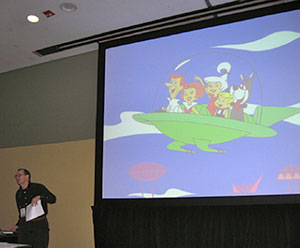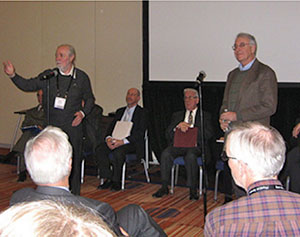A History of Physics in Industry
by Joseph D. Martin
 Investigating the history of industrial physics poses characteristic challenges. Corporate records are sparser and more difficult to access than university or non-profit archives. The disciplines that university departments wall off from one another often blend smoothly together on the floor of an industrial laboratory. Industrial research, rather than being shepherded rapidly into publication, is often subject to internal embargos. At the recent APS March Meeting in Baltimore, Maryland, an FHP-sponsored panel showcased various and creative ways in which historians are circumventing these challenges to understand the relationship between physics, industry, and enterprise. The four historians in panel M9: A History of Physics in Industry, explored four separate scales at which physics and industry interact, indicating just how rich a vein of historical insight future research in this direction promises.
Investigating the history of industrial physics poses characteristic challenges. Corporate records are sparser and more difficult to access than university or non-profit archives. The disciplines that university departments wall off from one another often blend smoothly together on the floor of an industrial laboratory. Industrial research, rather than being shepherded rapidly into publication, is often subject to internal embargos. At the recent APS March Meeting in Baltimore, Maryland, an FHP-sponsored panel showcased various and creative ways in which historians are circumventing these challenges to understand the relationship between physics, industry, and enterprise. The four historians in panel M9: A History of Physics in Industry, explored four separate scales at which physics and industry interact, indicating just how rich a vein of historical insight future research in this direction promises.
Tackling national trends, Orville Butler of the American Institute of Physics (AIP) provided the large-scale context that framed the panel. His progress report on the History of Physics Entrepreneurship project — a follow-up to the 2008 History of Physicists in Industry report — described the evolution of the resource ecology in which physics-based startups have emerged, emphasizing regional variation. With Joe Anderson, also of the AIP, Butler conducted interviews in 12 US States, from Massachusetts to California, and from Texas to Wisconsin. Especially notable conclusions include the unexpected rise in venture capital as an impetus for new enterprise, even after the 1990s tech bubble, and preliminary indications that the deepest well of innovation over the past two decades has come from new university-based startups rather than established corporations, which dominated the laboratory-to-marketplace pipeline in the mid-twentieth century.
Another perspective on the academia-industry connection came from Brittany Shields of the University of Pennsylvania, who focused on an individual institution. Shields’s case study of the Laboratory for Research on the Structure of Matter (LSRM) at the University of Pennsylvania demonstrated how the physical structure became an interdisciplinary space for the study of materials, and also a nexus where industrial, academic, and government interests intermingled. With the blurring of disciplinary lines came a parallel softening of institutional boundaries. Although the LSRM was a university laboratory staffed by university scientists, financial arrangements with IBM, Union Carbide, Westinghouse, and other local companies ensured that the lab remained attuned to industrial needs and interests.
Cyrus Mody — Rice University — directed the panel’s attention to the individual scale, considering physicists who parlayed their academic research and training into an electronics cottage industry — or, more appropriately, garage industry — in 1970s Santa Barbara. Mody highlighted conspicuous differences in how the boundaries of scientific legitimacy are negotiated in the marketplace as opposed to the academic power structure. Physicists like Philip Wyatt and David Phillips became interested in applying physical methods to parapsychology and alternative medical practices. Marginalized by the academic establishment, these physicists found a ready market for their skills within the 1970s counterculture movement. Mody, placing these physicists in the tinkerer tradition, demonstrates that their conviction that any phenomena could be fruitfully subjected to a rigorous experimental approach can’t be dismissed as mere quackery. The same impulse that drove their interest in devices to locate acupuncture points by measuring skin resistivity grounded research that helped the hearing impaired learn to enunciate, or assisted with hospital blood tests.

Bill Leslie

Brian Schwartz (left) and David Cassidy (right) at the discussion following the staged reading of Cassidy’s play Farm Hall, at the March meeting, March 20, 2013
Finally, Johns Hopkins’s Stuart W. Leslie introduced some of the other colorful personalities participating in Californian industrial research: the laboratories themselves. Leslie focused on laboratory architecture, suggesting that the edifices of Southern California aerospace and other high-technology industries reflected the aspirations of the space age. Western research firms did not merely offer jobs to physicists and engineers; they sold a lifestyle meticulously designed to lure talented young researchers who would typically be drawn to established East Coast labs. Leslie, like Shields, highlighted the spaces of research, aptly demonstrating how the futurist glass and steel structures, surrounded by gardens, pools, and tennis courts, encoded the prevailing values of mid- to late-twentieth century industrial research.
Evident from these talks were the ways in which the story of industrial physics does not fit neatly into the standard historical narratives crafted on the basis of universities and National Laboratories. Butler demonstrated that, although historians have come to think of federal funding as the engine of physics, a diverse array of venture capital, angel investment, state grants, and university commercialization funds have stoked an impressive array of physics-based innovations; but each funding mechanism brought with it different risks. Shields showed how industrial interests gained a toehold in an academic setting, complicating what are often treated as clean institutional categories. In an era of big science, a laboratory might still have been as modest as a garage, and Mody’s analysis exposed the academic gatekeeping mechanisms that can obscure the full range of physicists’ interests and activities. Industry, as Leslie illustrated, pushed the boundaries of laboratory design, and so offers crisp case studies historians can use to understand the sites of physical research. Together, these talks presented a convincing case that the history of physics has much to learn from closer inspection of industrial research, in all its dimensions.
Joseph D. Martin is a Faculty Fellow at Colby College.
The articles in this issue represent the views of their authors and are not necessarily those of the Forum or APS.
